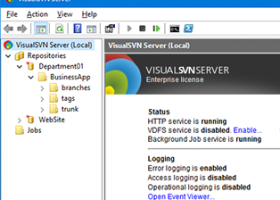

- #Migrate visualsvn user accounts to apache install
- #Migrate visualsvn user accounts to apache software
- #Migrate visualsvn user accounts to apache code
- #Migrate visualsvn user accounts to apache download
- #Migrate visualsvn user accounts to apache free
#Migrate visualsvn user accounts to apache install
Both need to be compatible, so you should always install the latest version of each. Tortoise works as a front-end UI to Subversion. Start by installing Subversion, and then install Tortoise SVN.

#Migrate visualsvn user accounts to apache free
If you want Visual Studio integration, check out VisualSVN ($49) or the free Ankh tool:
#Migrate visualsvn user accounts to apache download
You can download Tortoise SVN from here: To start, download Subversion and Tortoise SVN and install both. NET projects as well as with my old FoxPro projects-the process is no different, which is great for consistency and allows storage of all sorts of files from documentation to support files that otherwise wouldn’t be part of a Visual Studio project. Subversion is based on a file system tracking mechanism, so it is essentially tool agnostic. Subversion has actually made many scenarios that used to royally suck and required constant fiddling with Visual Studio and the source providers much easier. More importantly, I don’t miss the problems that go with integrated source control in Visual Studio with the provider manager often getting confused, especially in complex Visual Studio Solutions and shared project scenarios. I was skeptical about lacking Visual Studio integration when I started out, but I find I really don’t miss the integration with Visual Studio.
#Migrate visualsvn user accounts to apache code
Not having source control inside of Visual Studio may sound like blasphemy if you’ve used Visual SourceSafe, Vault, or another source code control provider before. Instead you simply work on your code and when you’re done you can check in all changes using Tortoise SVN. However, I’m finding that it allows considerably smoother development as you don’t have to worry about constant check-out/check-in scenarios and locking files for other users. Rather Subversion manages changes by merging source files with any changes made and only notifies you of conflicts if there are changes that cannot be merged (i.e., changes to the same line of code typically).Ĭoming from a background of using integrated security in Visual Studio, I at first had my doubts about the merge approach. Subversion subscribes to the Copy-Modify-Merge philosophy of source control, which means that files are never locked and nobody ever “owns” a file. This actually is very powerful as it lets you use a familiar Explorer interface as your source code browser and, more importantly, because it very easily lets you see source control files in relation to the actual directory structure and what is and isn’t under source control. You can graphically access Subversion via Tortoise SVN, which is an Explorer Shell Extension that provides access to most of Subversion’s command-line interface through Explorer Context menus and overlay icons for files under source control. Subversion is file based and keeps its repository in a simple directory structure that you can copy and back up easily. It’s fast and efficient, small and easy to install and because it’s open source-it’s also free. It is widely used by many open source projects and increasingly by many large development teams in general. Subversion is an open source control repository tool. This article isn’t meant to be a comprehensive tutorial on Subversion, but rather a quick, what-you-need-to-know, step-by-step guide to the essential tools to install and configure to get up and running. Subversion typically runs as a Service either using TCP/IP or HTTP, the latter of which requires Apache.

This article describes the steps to install and configure the Subversion source control tool and walks you through the basic steps required to set up local Visual Studio projects using Tortoise SVN. This article describes all you need to know to get started with Subversion and Tortoise SVN for Visual Studio projects. I recently got acquainted with the open source Subversion and Tortoise SVN tools and, for the first time, feel that this is source control that I can live with comfortably. It can help you manage your application more efficiently and make sure that your project is backed up and can be rolled back to any revision on the file or project level.
#Migrate visualsvn user accounts to apache software
Source control is an important aspect in software development even if you are not doing team development.


 0 kommentar(er)
0 kommentar(er)
